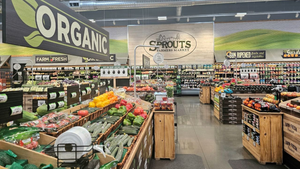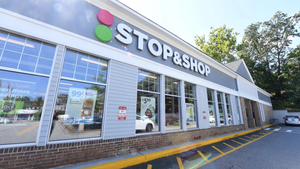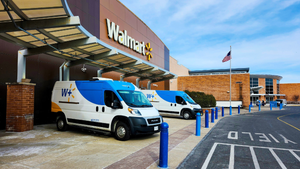LIGHT SPEEDLIGHT SPEED
Moving product cost-efficiently throughout the supply chain while keeping the goods in store-ready condition remains a key challenge for retailers. Supermarkets are investigating a number of technologies and practices to improve the movement of product in the warehouse and reduce waste due to damaged goods.Retailers implementing radio frequency communication and pick-to-light systems are realizing
November 8, 1999
PATRICK SCIACCA / KIM ANN ZIMMERMANN
Moving product cost-efficiently throughout the supply chain while keeping the goods in store-ready condition remains a key challenge for retailers. Supermarkets are investigating a number of technologies and practices to improve the movement of product in the warehouse and reduce waste due to damaged goods.
Retailers implementing radio frequency communication and pick-to-light systems are realizing dramatic efficiency improvements, including faster fork lift moves and reduced error rates, among other benefits.
Reusable plastic pallets and containers are also gaining favor in the effort to improve materials handling, providing ergonomically friendly protection for products as they move through the warehouse to the stores.
The Reusable Pallet and Container Coalition, Washington, was formed earlier this year to boost the use of reusable containers. "We've been successful in getting the sales-tax penalties on reusable plastic containers eliminated in California and we're are on the verge of getting the tax repealed in Florida," said Bob Reivik, president of the coalition and president of materials handling for Cookson Plastic Molding, a pallet vendor based in Latham, N.Y.
Some retailers, such as Wal-Mart Stores, Bentonville, Ark., are looking to increase their use of reusable plastic containers for shipping as well as for store merchandising. Meats and eggs are two products the retail giant is considering moving to RPCs, according to company officials.
By adding radio frequency identification to the RPCs, something Wal-Mart is getting set to test, according to company officials, the material can be tracked and inventoried more easily.
To take advantage of pick-to-light and other technologies that boost productivity in high-volume environments, Supervalu, Minneapolis, is in the process of consolidating slow-moving items into one warehouse. The wholesaler is in the process of centralizing the handling of these low-volume items, which include a lot of general-merchandise products such as toilet-bowl brushes. "When you have lower-volume products, it doesn't always makes sense to apply these technologies," said David Israel, general manager of Supervalu's Oglesby, Ill., distribution center, which handles slow-moving items. "But if you bring slow-moving items together in one warehouse, you can apply these same systems that improve the handling of your high-volume items," he noted.
BJ's Wholesale Club, Natick, Mass., has found that pallet-pooling and expanding its use of forklift clamps to remove and break down product on pallets can provide the retailer with a reduction in damaged/unsaleable product during the materials-handling process as well as provide a labor-cost savings.
"First of all, the [pooled] pallet is a higher quality pallet than the white-wood pallet, so it's durable and presents well in a warehouse club," said Ray Sareeram, senior vice president of logistics for BJ's.
About 30% of what BJ's processes through its supply chain is on pallets the retailer obtains through a third-party provider. The retailer has an agreement with the pallet provider to return the pallets in 30 days and BJ's is averaging 12 to 15 days on the pallet returns, according to Sareeram.
The improved strength of the pallets from the third-party provider has resulted in a significant reduction in product damage during the materials-handling process, he added.
Some of the materials-handling efficiency BJ's experiences may also be an offshoot of its unique materials-handling and supply-chain process.
Most of the product on the third-party pallets will come into a BJ's cross-docking center and go on a full pallet to the receiving door and then to the shipping floor. Then the pallet goes right into BJ's warehouse clubs where the product sits on the pallets through sales.
This supply-chain system allows for a minimal amount of product handling from the manufacturer to the consumer's hands.
It is cheaper for vendors to lease a pallet than to buy a white-wood pallet, Sareeram said, noting that some of those savings are passed on to BJ's.
In addition to pallet-pooling, BJ's has found materials-handling efficiency and a labor-cost savings through the use of forklift clamps for unloading floor-load trucks.
"When we get floor loads, we use handle clamp attachments on the forklift and pull out a group of boxes," Sareeram said.
Sareeram told SN that if a lumper were hired to unload a floor-load truck, it could take three or four hours. The clamps enable the retailer to unload the same truck in about an hour.
There is a tremendous labor-cost savings, he told SN.
While BJ's has achieved efficiencies through pallet programs, Lanzarotta Wholesale Grocers Ltd., Vaughan, Ontario, has seen an improvement in materials-handling productivity with a warehouse-management system upgrade.
"Recently we went with a new warehouse-management system," said Joe Donato, manager of warehousing and distribution for Lanzarotta's 200,000-square-foot distribution center.
"We've probably gained between 10% and 15% productivity [on picking and putaways in the warehouse]," he added.
The WMS, which was initially installed in 1997, has had new modules added on over the last two years and is as close to real-time as the wholesaler can get, Donato told SN, noting that the system keeps track of all inbound freight and where it's being stored.
Lanzarotta is considering a few other technologies to enhance its already improved materials-handling ability.
"I'm familiar with the pick-to-light [technology] and it may be down the road, [as well as] scanned picking," Donato said.
The scanned picking technology allows the warehouse worker to use a scanning unit mounted on the hand or a hand-held unit that scans the pick slots and identifies where product is located in the warehouse.
The information is then displayed on a screen, as opposed to Lanzarotta's current label-based picking system.
"[Scanned picking] can improve order accuracy to almost 100%," Donato told SN.
About the Author
You May Also Like
.webp?width=300&auto=webp&quality=80&disable=upscale)



